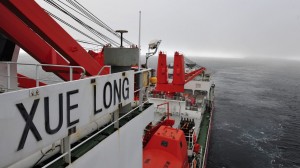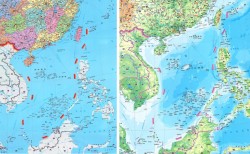The fortnight-long icy drama in Commonwealth Bay, Antarctica, is finally over and the two ice breakers, MV Akademik Shokalskiy of Russia, trapped since Christmas Eve, and Xue Long, the Chinese ship that came to rescue it, broke through the thick sea-ice and headed back to their routine summer deployment and scientific tasks.
It all began after Akademik Shokalskiy, carrying 74 people on board, made a distress call that it was unable to cut through the ice and was stranded. Xue Long, which was on its way to assist the construction of the new Chinese Antarctic station responded to the emergency, but could not break through the ice; it stopped six miles short of the distressed vessel. However, it successfully airlifted 52 passengers from the Russian ship but got trapped in the ice itself. In the early stages of these developments, two icebreakers France’s L’Astrolabe, and Australia’s Aurora Australis were also on deployment in the area but not expected to reach the scene quickly. However, it is Aurora Australis that ferried the rescued passengers to Hobart in Tasmania, Australia. During the course of the above events, the United States also dispatched its U.S. Coast Guard icebreaker Polar Star, but by then the two vessels had extricated from the sea-ice.
This rescue operation is a fine example of multinational effort, and the New York Times described it as a display of “unusual international harmony,” while the Global Times has glorified Xue Long‘s mission as an ‘epitome of China’s attitude towards its international obligations.’ It is useful to mention that Xue Long’s team includes scientists from Taiwan and Thailand.
 The above event merits attention in India, which has a proactive polar scientific research programme including acquisition of a polar research vessel. India has set up three permanent scientific research stations in Antarctica: ‘Dakshin Gangotri’ (1983), ‘Maitri’ (1989) and ‘Bharati’ (2012); as well as ‘Himadri’ (2007) in the Arctic. Their activities are coordinated by the National Centre for Antarctic & Ocean Research (NCAOR) at Goa, India.
The above event merits attention in India, which has a proactive polar scientific research programme including acquisition of a polar research vessel. India has set up three permanent scientific research stations in Antarctica: ‘Dakshin Gangotri’ (1983), ‘Maitri’ (1989) and ‘Bharati’ (2012); as well as ‘Himadri’ (2007) in the Arctic. Their activities are coordinated by the National Centre for Antarctic & Ocean Research (NCAOR) at Goa, India.
India’s polar expeditions are serviced by hiring or chartering ships for short durations from private parties in Germany, Russia, and Norway. India has announced plans to acquire a polar research vessel with specific requirements such as 45 days’ endurance, capable of cutting through 1.5-2 meter ice, accommodations for 60 scientists, a flight deck for helicopter operations, spaces for laboratories and instrumentation facilities for scientific research, and modern polar logistics support systems. Further, the vessel should be able to operate year-round in the Antarctic, Arctic, Southern, and Indian Oceans. The ship is expected to be in service by the end of 2016 and would cost about Rs 800 crore (U.S.$ 144 million).
Polar maritime activity is dependent not only on hi-quality ships, but also on competent human resourced. The ships’ crews have to be skilled and trained for navigation and engineering duties in sub-zero conditions. They also face a host of physical and psychological challenges arising from long periods of darkness, extreme cold, and fatigue, which could result in disorientation and can affect decision making. It is equally important to recognize that ‘a natural understanding based on experience of working in a cold environment cannot be assumed’ for Asian seafarers, unlike the seafarers from Scandinavia, Canada, or Russia, who are at less risk to cold injury than the Asians.
Likewise, the on-board helicopter and its crew must be competent handing air operations under treacherous polar conditions marked by blizzards, low-air temperatures, fog, low visibility, high-speed shifting winds, etc. Although chartered ships carry their own helicopters, between 1981 and 1995, the Indian Navy provided Chetak helicopters and the Indian Air Force deployed the Pratap helicopters for various duties including ferrying scientists, lifting stores, casualty evacuation and other shore tasks.
Another important facet of Antarctic deployment is voyage planning. The 2007 International Maritime Organisation (IMO) ‘Guidelines on Voyage Planning for Passenger ships operating in Remote Areas’ stipulate that any voyage planning through the Arctic or Antarctic must include a number of safety practices such as identification of safe areas and no-go areas, surveyed marine corridors, contingency plans for accidents, collisions, onboard fire, and search and rescue emergencies. Further, the voyage planning should also include information about icebergs and iceberg evasion procedures, weather, levels of darkness, safe speed, etc.
These material, human, and training requirements can potentially pose major challenges for India’s self sufficiency in its polar research programme and can be addressed through advanced planning and preparation including cooperative ventures with countries that have set up research stations and those which dispatch their research vessels to the polar regions.
This article was published in its original form at the Institute of Peace and Conflict Studies and was re-posted by permission. Dr. Vijay Sakhuja is Director (Research), Indian Council of World Affairs (ICWA), New Delhi. He is also Visiting Senior Research Fellow at the Institute of Southeast Asian Studies (ISEAS), Singapore since 2006. A former Indian Navy officer, Sakhuja’s research areas include politico-strategic developments in the Indian Ocean, Asia Pacific security, Arctic politics, and maritime and naval developments.








 The specter of nationalism in the Far East looms over ownership of the
The specter of nationalism in the Far East looms over ownership of the